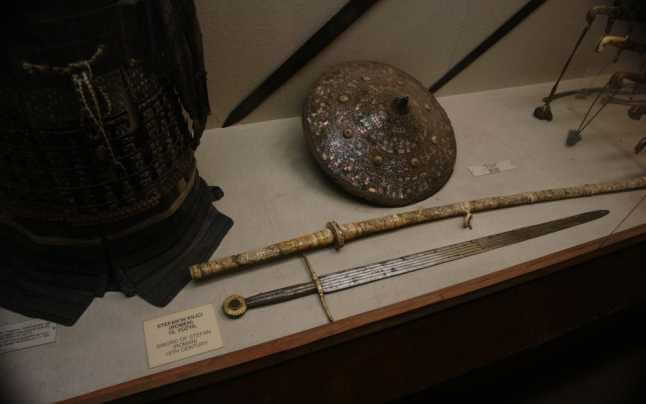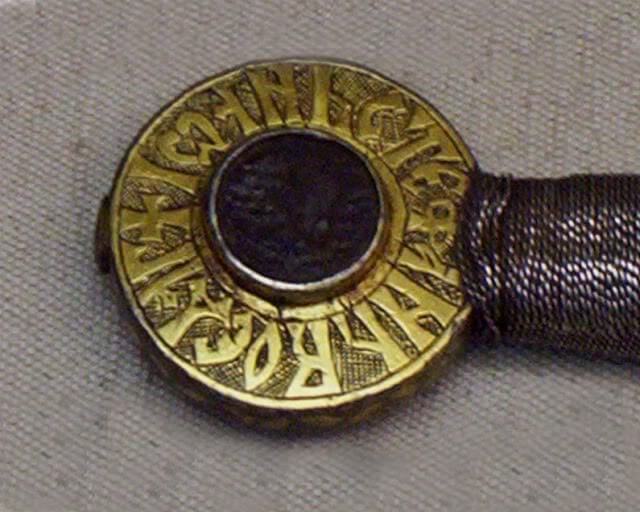Stephen the Great’s sword is one of the rare artifacts of the grand historical collection of the Topkapi Palace Museum.
The sword belonged to the Moldavian Ruler, Stephen III of Moldavia(known for his bravery as Stephen the Great); a weapon filled with legend, both revered and feared by the Ottomans, built from special steel at the personal instructions of the voivode.
In one of the greatest ironies in history, the sword of the Moldavian rulers who fought so hard against the Ottomans ended up in one of the halls of the former Royal Palace of the Ottoman Sultans.
For the audio version of the article.
In the Topkapi Museum in Istanbul, the former great palace of the Ottoman sultans, in the hall dedicated to weapons, next to a Japanese sword, there is a Moldavian sword. Simple and with a “rusty” blade, it attracts attention through its dimensions, but especially through the heraldry of the handle/grip and pommel.
Technical specifications
– total length: 125cm
– blade width: 60mm
– blade thickness: 4.34mm
– blade length: 102cm
– handle length: 23cm
– weight: 2.5 Kg
First of all the historians mention that it is a two-handed sword, with two edges, unlike a simple sword with one edge and one-handed.
The handle of the sword is covered with silver and the pommel(disc) from the end of the sword is decorated with the Moldavian Coat of Arms. The inscription can be translated as:” I, voivod Stephen”
The sword was not used in military campaigns, it was purely ceremonial, and according to some Romanian historians, it was only a symbol of power.
I. Stephen the Great’s sword – origins/ legends
There are three stories about the origins of the legendary sword of Stephen the Great.
1. A gift from Pope Sixtus IV.

After the Battle of Vaslui in 1475, Stephen III of Moldavia covered himself with glory by crushing the huge Ottoman invasion force that entered Moldavia.
Impressed by the Moldavian prince’s achievement, Pope Sixtus IV gave him the title of “Athleta Christi”(Champion of Christ), but also two gifts, a battle flag and a sword, the one present today in Topkapi Palace from the point of view of some historians.
At the orders of the Pope, the sword was made in the workshops of Italian gunsmiths, being personally blessed by the Pope and especially blessed in Rome. That is why some people consider that the sword also has some divine/magical powers.
2. Crafted at the orders of Stephen the Great

The second theory, which is accepted as the most credible, is that the sword was crafted in Italian, Genoese workshops at the command of Stephen the Great.
Basically, the Moldavian voivode wanted a sword made by the best gunsmiths in Europe and gave a special order.
Modern-day historians support this claim after the discovery of correspondence between Stephen the Great and Genovese gunsmiths by Nicolae Iorga. According to the documents studied by the Romanian historian, an armorer by the name of Cristofor, who worked at the workshop that made such weapons, talked with the gunsmiths, not knowing this type of sword, should send someone to Moldova to find out,” says Carol Konig. A Genoese gunsmith was sent to Moldova to study the Moldavian sword model. Eventually, the voivode’s order was honored, with the Genoese handing over a weapon made of Toledo Steel, the most resistant and removed steel at the time in Europe.
3. A symbol of power, inherited from generation to generation
On the other hand, the Romanian historian Stefan Gorovei, a specialist in the reign of Stephan the Great, says that the sword is, most probably, a symbol of power and that it was not made by the Genoese nor received as a gift from the Pope, but inherited generation after generation of Moldavian rulers since the founding of Moldova.
More precisely, the Romanian historian considers that the sword belonged to Dragos Voda(first Moldavian Ruler) and passed after to the following rulers of Moldova, during the crowning ceremonies.
II. How the Ottomans captured Stephen the Great’s sword?

It is hard to determine how Stephen the Great’s sword ended up in the collection of the Topkapi Palace because the weapon doesn’t show in the records neither as a gift nor captured during a war.
There are multiple scenarios even for the capture of the sword of the great Moldavian ruler’s sword by the Ottomans.
1. Stephen the Great surrendered the sword to the Ottomans
It is assumed that Stephen the Great personally handed over his sword to the Ottomans when he agreed to pay tribute at the end of his long reign. However, it is unlikely that the Moldavian voivode would simply give up the symbol of the Moldavian dynasty.
2. The sword was stolen during a great Ottoman invasion
The second legend places the moment of losing the sword at the end of Petru Rareș’s first reign. Son of Stephen the Great, Petru Rares tried to restart the anti-Ottoman crusade in 1538.
The retaliatory campaign of Sultan Soliman the Magnificent would lead to the loss of his reign and Petru Rares was forced to take refuge into Transylvania. The Ottoman troops imposed Stephen V, known as “Lăcustă-Vodă”, as ruler of Moldova. The Turks plundered the treasury of Moldova before retreating, taking with them the sword of Stephen the Great.
III. Attempts by the Romanian Government to recover the sword.
For 460 years, the sword never left Turkey. Many times, the Romanian authorities requested the original sword, motivating that Stephen the Great is a true symbol for Romania. All their efforts were in vain. The response from Turkish officials was negative. What is the reason? The Turks do not want to set a precedent for other nations to start demanding their historical treasures/artifacts from their museums.
On the 500th anniversary of the death of Stephen the Great, the Romanian and Turkish authorities agreed that the ruler’s sword should be transferred and put on display for a limited time in Bucharest, the capital of Romania.
On the occasion of the events of July 2004 (500 years after Stephen the Great’s death), the ruler’s sword was put on display at the National Museum of Art of Romania.
On this occasion, the Government of Turkey donated a copy of the sword to the Romanian state. The copy of the sword of Stephen the Great, itself a work of art, was donated to Putna Monastery(which was built by the Moldavian ruler) by the Romanian Government.
In 2012, another replica of the sword was gifted by the Turkish Government to the Republic of Moldova, the second copy of the sword is currently on display in the Soroca Museum.
Why Stephen the Great waged so many wars?
Voivode Stephen the Great was one of the most warrior princes in Eastern Europe in the 15th century. His bravery on the battlefield was recognized, is attested to the fact that he personally entered the battle with the royal guard and sowed terror by encouraging his army. In fact, this is what the old chronicles show.
According to a popular tradition, Stephen the Great has built an equal number of churches to the number of military campaigns he waged, so that, according to the data provided by chronicler Grigore Ureche, the ruler of Moldova led no less than 44 campaigns, almost one for each year of his reign. Stephen the Great fought against all his neighbors, whether it was the Ottoman Empire, the Kingdom of Hungary, Poland or Wallachia, the Tatar khanates, or the duchy of Lithuania.
Romanian historiography has credited the idea that Stephen was forced to wage these wars, with an eminently defensive character, to defend the country and the Christian faith from foreign attempts to conquer, the most dangerous being those of the Ottomans.
